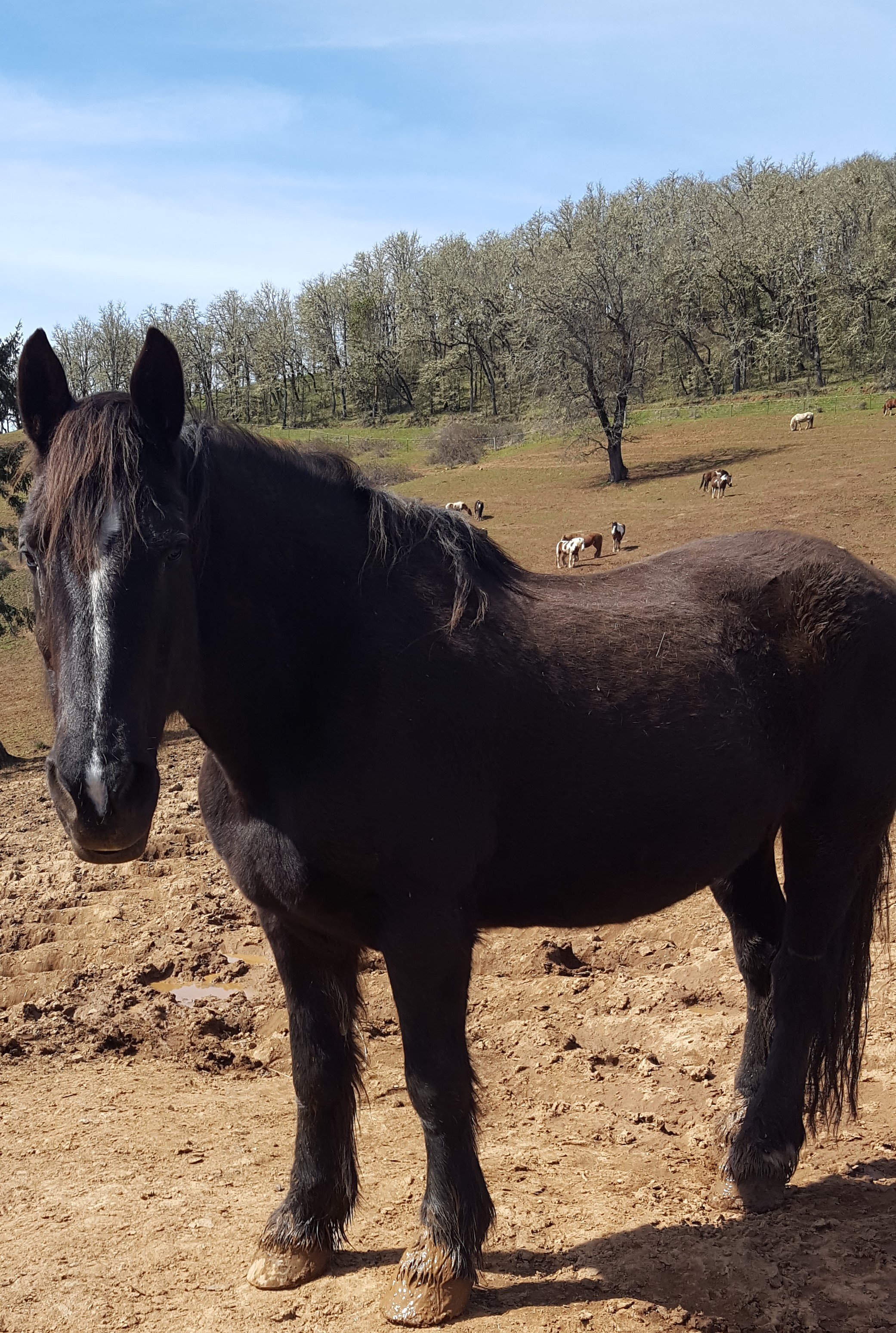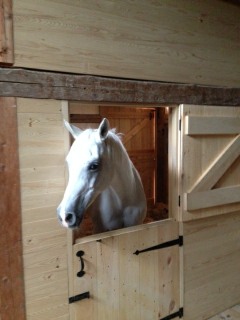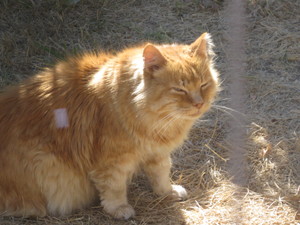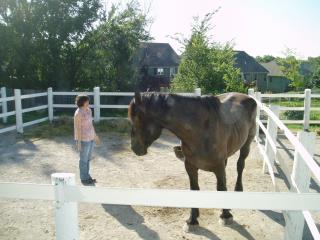The massive draft horse was one of the saddest, checked-out animals I have met. He’d spent years on at least one Amish farm, was isolated and probably abused, and had given up. His new owner, the director of a nonprofit equine therapy center, wanted to find out what he needed.
The first thing I did was ask if it was OK to communicate with him. Surprised but skeptical, he agreed. The notion that he could choose anything was foreign to him.
That is the core of the Let Animals Lead® method I practice. It’s all meditation and no hands unless the animal initiates contact, or the practitioner knows the animal well enough to gauge whether that would be welcome.
One day Duke decided he’d had enough Reiki and walked back into the barn. I thanked him and moved on to a pig a few feet away.
A few minutes later, Duke stuck his big head out the barn door and looked straight at me. “Got any more of that?” I heard.
I assured him I did, but he’d have to wait until the pig and I were done. When I returned, he was waiting at the fence. I met his eyes and saw hope.
His owner, veterinarians, equine bodyworkers, clients, and I all worked to help Duke heal from the effects of his past, giving him choices whenever possible. He still struggles mightily with triggers. But he has friends in the herd. He connects with veterans who also live with PTSD. He even let kids dress him up for the Fourth of July. Being a therapy horse would have been unthinkable for Duke not so long ago.
While we can’t let our animals choose to play in traffic or opt out of a vet visit, there are many other options we can offer. We can give them a choice of toys, blankets, or litter boxes. We can hold out two different treats and see which gets gobbled up first. We can let cats come to us rather than chasing or picking them up. We can suggest a walk or ride and pay attention to the dog’s body language for a “let’s go” or a “not today.”
Choice frees us all to engage honestly, be our best selves, and create our “better than before.”
By SARA Practitioner Nancy Crowe
















 She was 21 when I adopted her from the rescue. I found her online, a Google search. I typed in white Arabian mare and she was the first to appear. I knew immediately she was the one.
She was 21 when I adopted her from the rescue. I found her online, a Google search. I typed in white Arabian mare and she was the first to appear. I knew immediately she was the one. Often, when I meditated in bed, she would “appear” and the meditation quickly entered a dimension I could not find on my own.
Often, when I meditated in bed, she would “appear” and the meditation quickly entered a dimension I could not find on my own.








 Sharing will enrich everyone with more knowledge. ~Ana Monnar
Sharing will enrich everyone with more knowledge. ~Ana Monnar Two of my newer students asked for some guidance as we began the afternoon. So, we went together to offer Reiki to Smokey and Buddy who were sharing a small pasture near the house. These two sweet horses along with some other sweet spirits taught my students about just “Being Reiki” and letting go of what might happen. We sat outside the fence overlooking the countryside. After I guided us in creating a Reiki space and inviting Smokey and Buddy to join us, we sat in the beautiful healing energy. Smokey and Buddy moved around a bit as they grazed, but stayed a few feet away sharing the energy with us.
Two of my newer students asked for some guidance as we began the afternoon. So, we went together to offer Reiki to Smokey and Buddy who were sharing a small pasture near the house. These two sweet horses along with some other sweet spirits taught my students about just “Being Reiki” and letting go of what might happen. We sat outside the fence overlooking the countryside. After I guided us in creating a Reiki space and inviting Smokey and Buddy to join us, we sat in the beautiful healing energy. Smokey and Buddy moved around a bit as they grazed, but stayed a few feet away sharing the energy with us. And at one point, I happened to look over to my right where Sadie, a very sweet donkey, had been grazing nearby; she was looking at us very intently and quietly connecting with us. After we finished, the owner of the sanctuary, Jody, shared that as she was taking pictures, she noticed that the cats in the house had all congregated at the window just behind us; they too were connecting with us. Wow, what a great learning experience for all of us. If we create a Reiki space and invite all of the animals to connect with us, we are able to assist not only those that we intend to work with, but also any others who may choose to join us.
And at one point, I happened to look over to my right where Sadie, a very sweet donkey, had been grazing nearby; she was looking at us very intently and quietly connecting with us. After we finished, the owner of the sanctuary, Jody, shared that as she was taking pictures, she noticed that the cats in the house had all congregated at the window just behind us; they too were connecting with us. Wow, what a great learning experience for all of us. If we create a Reiki space and invite all of the animals to connect with us, we are able to assist not only those that we intend to work with, but also any others who may choose to join us. For our second practice session, I was inspired to spend time with the horses in the barn. Yoda and Mikey were in their stalls next to each other, and Cziello was across the aisle. I had worked with Yoda in the past, so I stood in the middle of the aisle facing Yoda and invited all three horses to join me in the Reiki space. Yoda knew why I was there and stayed at the front of his stall often reaching his head out toward me; he was very sweet and open to the energy. Just as I was about to move closer to Yoda, he moved back in his stall, and I immediately felt something warm over my left shoulder. I looked back, and there was Cziello extending his head as far as he could toward me, almost brushing his muzzle against me. I turned around to face Cziello and moved right in front of him placing my hands under his muzzle. He continued looking directly at me; he would push his muzzle into my hands; he would lift his head and smile; and he would cock his head to one side. I just stood there mirroring his movements and sharing the moment with him. Thank you to Cziello for this wonderful experience and for sharing such a beautiful and peaceful connection with me.
For our second practice session, I was inspired to spend time with the horses in the barn. Yoda and Mikey were in their stalls next to each other, and Cziello was across the aisle. I had worked with Yoda in the past, so I stood in the middle of the aisle facing Yoda and invited all three horses to join me in the Reiki space. Yoda knew why I was there and stayed at the front of his stall often reaching his head out toward me; he was very sweet and open to the energy. Just as I was about to move closer to Yoda, he moved back in his stall, and I immediately felt something warm over my left shoulder. I looked back, and there was Cziello extending his head as far as he could toward me, almost brushing his muzzle against me. I turned around to face Cziello and moved right in front of him placing my hands under his muzzle. He continued looking directly at me; he would push his muzzle into my hands; he would lift his head and smile; and he would cock his head to one side. I just stood there mirroring his movements and sharing the moment with him. Thank you to Cziello for this wonderful experience and for sharing such a beautiful and peaceful connection with me. It seems like almost every day I am getting these emails from people I know who are working tirelessly to stop the massive removal of these magnificent animals from their homelands. Wild horses have roamed our countryside for hundreds of year. Yet now, under the direction of the government, the Bureau of Land Management (BLM) is staging nationwide roundups of wild horses so they can turn over the land to cattle ranchers. While I have never witnessed a roundup live, friends of mine have. I have seen harrowing pictures and video and heard tragic stories. Once they are captured, the lucky horses are saved by rescue groups and sent to sanctuaries. They will never again roam free, but they are safe. The unlucky ones are sent to feedlots where they are held in small pens indefinitely or possibly shipped to slaughter.
It seems like almost every day I am getting these emails from people I know who are working tirelessly to stop the massive removal of these magnificent animals from their homelands. Wild horses have roamed our countryside for hundreds of year. Yet now, under the direction of the government, the Bureau of Land Management (BLM) is staging nationwide roundups of wild horses so they can turn over the land to cattle ranchers. While I have never witnessed a roundup live, friends of mine have. I have seen harrowing pictures and video and heard tragic stories. Once they are captured, the lucky horses are saved by rescue groups and sent to sanctuaries. They will never again roam free, but they are safe. The unlucky ones are sent to feedlots where they are held in small pens indefinitely or possibly shipped to slaughter. Pete lives at a barn near Green Bay, WI, with a wonderful family, about 10 horses and a couple of mini horses, a place where he receives a lot of love and attention. Pete’s life has not always been so idyllic. Pete came to live with Diane from a place where he was most likely abused and not well-cared for. It seems that Pete received little attention; he was kept in his stall most of the time; and his stall was rarely cleaned. These people really did not want Pete, and luckily for him, Diane was willing to give him a loving home. As a result of his past, Pete had lost trust in humans and responded very cautiously and fearfully when people came near him or tried to ride or interact with him.
Pete lives at a barn near Green Bay, WI, with a wonderful family, about 10 horses and a couple of mini horses, a place where he receives a lot of love and attention. Pete’s life has not always been so idyllic. Pete came to live with Diane from a place where he was most likely abused and not well-cared for. It seems that Pete received little attention; he was kept in his stall most of the time; and his stall was rarely cleaned. These people really did not want Pete, and luckily for him, Diane was willing to give him a loving home. As a result of his past, Pete had lost trust in humans and responded very cautiously and fearfully when people came near him or tried to ride or interact with him. I recently had the pleasure of spending a weekend doing Reiki with rescued horses at BrightHaven Animal Rescue. Located in the Northern California town of Santa Rosa, BrightHaven is an amazing place, and I find myself wanting to tell everyone about it. First and foremost, it is a home for senior, disabled and terminally ill animals. All the animals there are at least 16 years old; the horses are all over the age of 26. Founded by Gail and Richard Pope in 1990, BrightHaven is their home also. Indoors you will see many senior cats and dogs – some partially paralyzed. Some of the dogs can be seen tearing around the back yard on their “wheels,” almost as fast as any dog you’ve ever seen.
I recently had the pleasure of spending a weekend doing Reiki with rescued horses at BrightHaven Animal Rescue. Located in the Northern California town of Santa Rosa, BrightHaven is an amazing place, and I find myself wanting to tell everyone about it. First and foremost, it is a home for senior, disabled and terminally ill animals. All the animals there are at least 16 years old; the horses are all over the age of 26. Founded by Gail and Richard Pope in 1990, BrightHaven is their home also. Indoors you will see many senior cats and dogs – some partially paralyzed. Some of the dogs can be seen tearing around the back yard on their “wheels,” almost as fast as any dog you’ve ever seen. A goat also makes her home at BrightHaven, as well as some ducks, geese, and I just don’t even know who else. It is truly a safe haven for all.
A goat also makes her home at BrightHaven, as well as some ducks, geese, and I just don’t even know who else. It is truly a safe haven for all. As someone who has been struggling with health issues of my aging cats for the last several years, I am amazed and humbled by the efforts of Gail and Richard. I know first hand how difficult it is when your animals get older and have special needs. I’m sure many of you do, too. How they care for so many “special needs” animals through the end of life transition is beyond my capacity to imagine. And the care and love that the animals at BrightHaven receive is beyond description.
As someone who has been struggling with health issues of my aging cats for the last several years, I am amazed and humbled by the efforts of Gail and Richard. I know first hand how difficult it is when your animals get older and have special needs. I’m sure many of you do, too. How they care for so many “special needs” animals through the end of life transition is beyond my capacity to imagine. And the care and love that the animals at BrightHaven receive is beyond description. Sandy is a pretty little buckskin mare approximately 24 years old who came to Horse Rescue in 2000 when she was rescued with some of her friends from a herd of 22 ponies running wild in a 10-acre paddock. At the time Sandy had a very young foal at foot and another still suckling from her. She had probably spent her life before HRA having babies. Sandy was so scared of people HRA carers couldn’t go near her without her trembling like a mouse. She is very smart, and very good at not being caught!
Sandy is a pretty little buckskin mare approximately 24 years old who came to Horse Rescue in 2000 when she was rescued with some of her friends from a herd of 22 ponies running wild in a 10-acre paddock. At the time Sandy had a very young foal at foot and another still suckling from her. She had probably spent her life before HRA having babies. Sandy was so scared of people HRA carers couldn’t go near her without her trembling like a mouse. She is very smart, and very good at not being caught!







